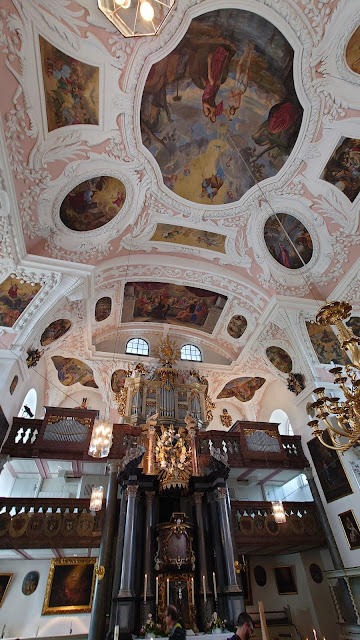 |
| Ordenskirche St Georgen, Bayreuth |
Couperin: Trois Leçons de Ténèbres pour le Mercredi Saint; Chantal Santon, Marie Théoleyre, Loris Barrucand, François Gallon; Bayreuth Baroque Opera Festival at Ordenskirche St Georgen
Reviewed 10 September 2022 (★★★★)
Wonderfully idiomatic performances of Couperin's surviving lessons bringing out the rhetorical aspect of the music
Saturday afternoon's concert (10 September 2022) at Bayreuth Baroque Opera Festival took place in the Ordenskirche St Georgen in what is now Bayreuth St Georgen, a suburb. But in the early 18th century it was to be planned new town surrounding a palace by an artificial lake, which had been created in the 17th century so the then Margrave could sail his model boats. It wasn't finished and the palace became a prison. The church, however, is glorious; almost square, galleried and delightfully elaborate. Completed in 1711, it was the church for the Margrave's order of knighthood, the Ordre de la Sincérité.
The concert took us to the France contemporary with the church, as Chantal Santon (soprano), Marie Théoleyre (soprano), Loris Barrucand (organ) and François Gallon (cello) performed Couperin's Trois Leçons de Ténèbres pour le Mercredi Saint. Written for performance in the Abbaye royale de Longchamp in 1714 they were originally part of a group, but the other two sets of lessons for Thursday and Friday have alas been lost. Illness had forced a change of cast with Chantal Santon stepping in, but you couldn't tell.
The performers gave us an affecting sequence of 18th century French music, but frustratingly not everything was specified, and I am not sure which singer sang which lesson. So we began with two unaccompanied, invisible voices as if from the heavens, singing I think, part of Couperin's third lesson. Then an organ prelude leading into the first lesson, for solo soprano, organ and cello. Though her diction was not quite crisp, it was good to have a native French speaker singing the French-inflected Latin. Her voice had an attractive richness to it, with an expressive use of vibrato.
After a second organ prelude, the second soprano sang the second lesson. Her voice was similarly rich but with a nice bright edge to it. Neither singer had bland, white Early Music voices and both brought a sense of rich style. Their performances brought out the rhetorical nature of the music, the sense that this was the musical expression of an important text, rather than pure, beautiful music.
We then heard a cello sonata by Jean-Baptiste Barrière; four movements, slow, fast, slow, fast, showing off Gallon's rich chestnutty cello tones. In the Couperin he came to the fore just in the occasional cello flourishes, but here Gallon was centre stage, showcasing fine technique and a lovely speaking tone, from the melancholy first movement to the lively dance of the finale.
In the final lesson, the two voices came together, bringing a brilliant spicy edge to the false relations and intensifying the rhetoric. There was no sense of calm beauty, instead intense involvement in the rather dramatic words.
Throughout the Couperin the singers received fine support from Gallon and Barrucand, and there was a great sense of this being a collaborative venture rather than cello and organ simply accompanying.
The enthusiastic reception from the audience seemed to take the performers by surprise but were were treated to a fine account of 'Pulchra es' from Monteverdi's Vespers of 1610



%20and%20kids.jpg)
.webp)





.jpg)
No comments:
Post a Comment